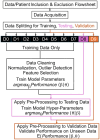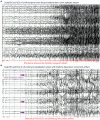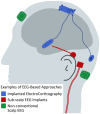The present and future of seizure detection, prediction, and forecasting with machine learning, including the future impact on clinical trials
- PMID: 39055320
- PMCID: PMC11269262
- DOI: 10.3389/fneur.2024.1425490
The present and future of seizure detection, prediction, and forecasting with machine learning, including the future impact on clinical trials
Abstract
Seizures have a profound impact on quality of life and mortality, in part because they can be challenging both to detect and forecast. Seizure detection relies upon accurately differentiating transient neurological symptoms caused by abnormal epileptiform activity from similar symptoms with different causes. Seizure forecasting aims to identify when a person has a high or low likelihood of seizure, which is related to seizure prediction. Machine learning and artificial intelligence are data-driven techniques integrated with neurodiagnostic monitoring technologies that attempt to accomplish both of those tasks. In this narrative review, we describe both the existing software and hardware approaches for seizure detection and forecasting, as well as the concepts for how to evaluate the performance of new technologies for future application in clinical practice. These technologies include long-term monitoring both with and without electroencephalography (EEG) that report very high sensitivity as well as reduced false positive detections. In addition, we describe the implications of seizure detection and forecasting upon the evaluation of novel treatments for seizures within clinical trials. Based on these existing data, long-term seizure detection and forecasting with machine learning and artificial intelligence could fundamentally change the clinical care of people with seizures, but there are multiple validation steps necessary to rigorously demonstrate their benefits and costs, relative to the current standard.
Keywords: deficiency time; epilepsy; human-in-the loop; internet of things; wearables.
Copyright © 2024 Kerr, McFarlane and Figueiredo Pucci.
Conflict of interest statement
WK has received compensation for review articles for Medlink Neurology and consulting for SK Life Sciences, Biohaven Pharmaceuticals, Cerebral Therapeutics, Jazz Pharmaceuticals, EpiTel, UCB Pharmaceuticals, Azurity Pharmaceuticals, and the Epilepsy Study Consortium; and has collaborative or data use agreements with Eisai, Janssen, Radius Health, and Neureka. The remaining authors declare that the research was conducted in the absence of any commercial or financial relationships that could be construed as a potential conflict of interest.
Figures







Similar articles
-
Seizure Diaries and Forecasting With Wearables: Epilepsy Monitoring Outside the Clinic.Front Neurol. 2021 Jul 13;12:690404. doi: 10.3389/fneur.2021.690404. eCollection 2021. Front Neurol. 2021. PMID: 34326807 Free PMC article. Review.
-
Seizure forecasting using machine learning models trained by seizure diaries.Physiol Meas. 2022 Dec 14;43(12):10.1088/1361-6579/aca6ca. doi: 10.1088/1361-6579/aca6ca. Physiol Meas. 2022. PMID: 36541513 Free PMC article.
-
Seizure forecasting and cyclic control of seizures.Epilepsia. 2021 Feb;62 Suppl 1:S2-S14. doi: 10.1111/epi.16541. Epub 2020 Jul 26. Epilepsia. 2021. PMID: 32712968 Review.
-
Artificial intelligence-enhanced epileptic seizure detection by wearables.Epilepsia. 2023 Dec;64(12):3213-3226. doi: 10.1111/epi.17774. Epub 2023 Oct 25. Epilepsia. 2023. PMID: 37715325
-
Machine learning seizure prediction: one problematic but accepted practice.J Neural Eng. 2023 Jan 18;20(1). doi: 10.1088/1741-2552/acae09. J Neural Eng. 2023. PMID: 36548993
Cited by
-
The use of AI in epilepsy and its applications for people with intellectual disabilities: commentary.Acta Epileptol. 2025 Feb 19;7(1):13. doi: 10.1186/s42494-025-00205-7. Acta Epileptol. 2025. PMID: 40217440 Free PMC article.
-
The prophet's rite of passage - pitfalls in evaluating real-time prediction in medicine.Front Physiol. 2025 Apr 9;16:1569008. doi: 10.3389/fphys.2025.1569008. eCollection 2025. Front Physiol. 2025. PMID: 40271212 Free PMC article. No abstract available.
-
Chasing the Holy Grail: Seizure Prediction Through Neural Cycles.Epilepsy Curr. 2024 Oct 30;25(1):48-50. doi: 10.1177/15357597241281842. eCollection 2025 Jan-Feb. Epilepsy Curr. 2024. PMID: 39539397 Free PMC article. No abstract available.
-
The hidden rhythms of epilepsy: exploring biological clocks and epileptic seizure dynamics.Acta Epileptol. 2025 Jan 3;7(1):1. doi: 10.1186/s42494-024-00197-w. Acta Epileptol. 2025. PMID: 40217344 Free PMC article. Review.
References
-
- LaFrance WC, Ranieri R, Bamps Y, Stoll S, Sahoo SS, Welter E, et al. . Comparison of common data elements from the managing epilepsy well (MEW) network integrated database and a well-characterized sample with nonepileptic seizures. Epilepsy Behav. (2015) 45:136–41. doi: 10.1016/j.yebeh.2015.02.021, PMID: - DOI - PubMed
Publication types
LinkOut - more resources
Full Text Sources

